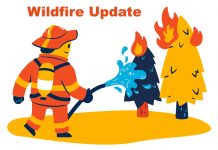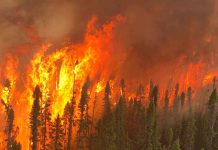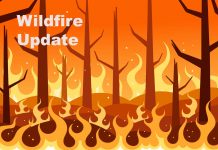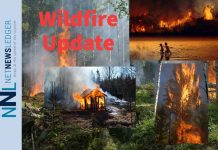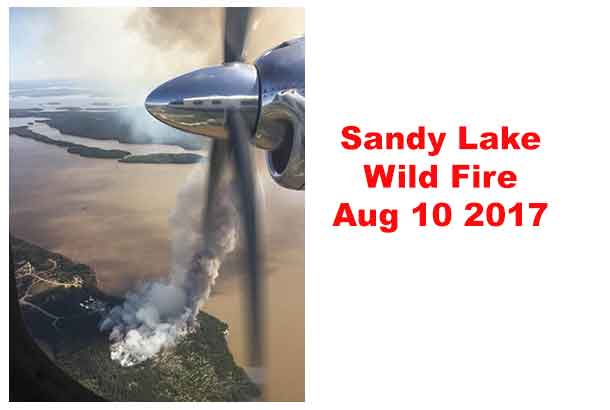
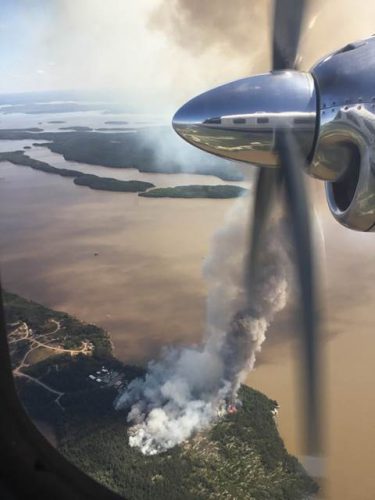
FireRangers have circled the fire with hose line but it is still listed as not under control at 10 hectares.
Constant air attack from Ontario, with assistance from Manitoba, and helicopter bucketing helped
stop the fire from advancing to homes and fuel tanks.
THUNDER BAY – WILDFIRE UPDATE – The situation across Northwestern Ontario continues to heat up in terms of the forest fires in the region.
There were five new fires confirmed by the afternoon of August 11 in the Northwest Region and new lightning strikes in the north were bringing in more reports.
There were 25 new fires confirmed by day’s end on August 10.
Multiple fires remain active in the region, totaling 103 fires at the time of this report.
One fire of note is Red Lake Fire 066 within the community of Sandy Lake First Nation. It required aggressive attack from the ground and the air under extreme fire hazard conditions. It is responding well to suppression efforts.
Another fire of note is Nipigon District Fire Number 29, a 1,000 hectare fire located about 20 kilometres north of Nibinamik First Nation. An incident management team is now in place to manage the fire and to ensure that spread toward the community is limited Smoke will be an issue for the next few days.
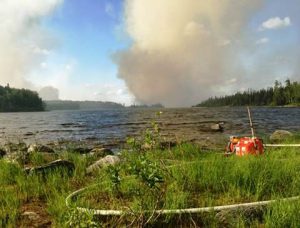
toward the community of Nibinamik to the south.
There are a number of lightning-caused fires burning in and around Wabakimi Provincial Park. Some require suppression efforts but some will be monitored while they burn to natural boundaries and renew the forest ecosystem in the park.
Wildland fire can play a natural role in maintaining and restoring the forest ecosystem.
To track the fire hazards and to see a complete list of fires across the province click on our interactive map. You can also get the latest update on the condition of any fire by clicking the fire icons.
The majority of the new fires are caused by lightning but some are still attributed to human-causes.
Out of Province Deployment
Currently there are approximately 150 staff supporting the province of British Columbia in their fire management efforts.
Ontario, as part of the Great Lakes Forest Fire Compact (GLFFC) including Michigan, Minnesota and Wisconsin has formed international crews of firefighters currently deployed to British Columbia.
Ontario continues to have firefighting staff on the ground in British Columbia to help support ongoing firefighting efforts. This is being done while also ensuring we have the necessary firefighting personnel here at home. So far since mid-July, four large contingents of FireRangers that had been deployed out of province have now returned to Ontario from BC.
The public is urged to take an active role in preventing more fires. This can be done by not burning when it is windy, monitoring your fire and ensuring that you have water nearby to extinguish your fire. As a reminder, there is no day burning of brush and grass.
Planning to have a campfire?
Here are some tips on how to safely enjoy your campfire and avoid the costs and dangers that can arise from an unextinguished or unattended campfire:
- Choose your site carefully. Select a site with easy access to water that is sheltered from high winds. The fire must be built on bare rock or non-combustible material.
- Prepare the site. Clear a one metre space around your campfire site and remove all pine needles, grasses, leaves and twigs.
- Keep your fire small. By law, your campfire cannot exceed one metre in height and one metre in diameter.
- Stay nearby. Never leave your campfire unattended.
- Put your fire out. Soak your fire with water.
- Be sure the fire is extinguished. Stir the ashes with a stick to uncover hot coals and then soak it again!
Ontario has increased the maximum fines for individuals and corporations for starting forest fires.
Increased Fines for Starting a Forest Fire
Fire numbers and online information:
- Forest Fire Reporting Number – 310-FIRE (3473)
- Follow us on Twitter: in English @ONForestFires or in French @ONFeuDeForêt
- For guidelines on safe outdoor fire management ontario.ca/fireprevention

